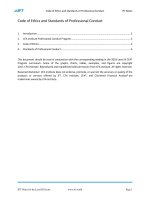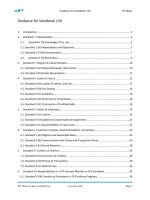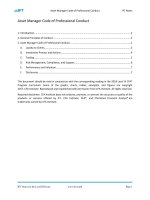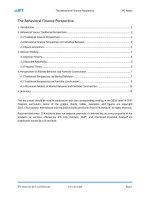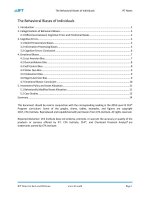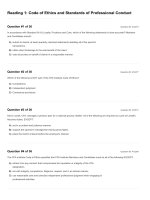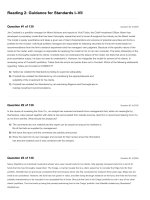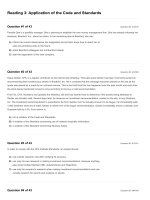CFA 2018 level 3 schweser practice exam CFA 2018 level 3 question bank 27 q
Bạn đang xem bản rút gọn của tài liệu. Xem và tải ngay bản đầy đủ của tài liệu tại đây (92.56 KB, 18 trang )
CFA LEVEL-III, PRACTICE QUESTIONS
Reading # 25: Risk Management
| Questions
Question 1 - #93243
Which of the following operations applies to the monitoring and evaluation systems of an enterprisewide risk management (ERM) system?
A)
Performing diagnostics on the pricing, value at risk (VAR) computations, and dat
B)
Computing stress testing to complement traditional value at risk (VAR) based ris
C)
Computing value at risk (VAR) metrics for all risks across the firm.
Question 2 - #92893
Which of the following regarding an effective risk management model is least accurate?
A)
When a risk management problem is viewed as a long-run change in fundamenta
B)
Duration and delta are sufficient for modeling the risk of bonds and options.
C)
When a risk management problem is viewed as temporary, the best course of acti
Question 3 - #93215
A manager wishes to lower the financial risk of a portfolio. She looks at the risks of her portfolio
associated with currencies and commodities. In attempting to lower the financial risk associated with
her portfolio, she should hedge:
A)
the risk of neither currencies nor commodities because neither are associated with
B)
the risk associated with currencies, but not commodities since commodities are u
C)
the risk associated with both currencies and commodities.
Question 4 - #93234
One goal of all risk management systems should be to:
A)
make the risk level equal to the prevailing level in the market.
B)
bring the level of risk to a desired level of risk, which may exceed zero.
C)
eliminate all risk, i.e., reduce risk to zero.
Question 5 - #93194
Jenny Rouse has been a portfolio manager for Theta Advisors for the last five years. The
performance of her portfolio has had few returns below its benchmarks since its inception. Which of
the following risk measures best measures Rouse’s performance?
A)
B)
C)
Question 6 - #92353
With respect to value at risk (VAR), regulatory agencies:
A)
in some industries require its computation and reporting.
B)
have mandatory requirements in all financial industries.
C)
are studying it, but none have adopted its use.
Sortino r
Standard
Sharpe ra
Question 7 - #126906
Mark Stober, William Robertson, and James McGuire are consultants for a regional pension
consultancy. One of their clients, Richard Smitherspoon, chief investment officer of Quality Car Part
Manufacturing, recently attended a conference on risk management topics for pension plans.
Smitherspoon is a conservative manager who prefers to follow a long-term investment strategy with
little portfolio turnover. Smitherspoon has substantial experience in managing a defined benefit plan
but has little experience with risk management issues. Smitherspoon decides to discuss how Quality
can begin implementing risk management techniques with Stober, Robertson, and McGuire.
Quality's risk exposure is evaluated on a quarterly basis.
Smitherspoon is curious about risk management techniques, and in particular the concept of VAR.
He asks, "What does a daily 5% VAR of $5 million mean? I just get so confused with whether VAR
is a measure of maximum or minimum loss. Just last month, the consultant from MinRisk, a
competing consulting firm, told me it was 'a measure of maximum loss, which in your case means
we are 95% confident that the maximum 1-day loss is $5.0 million.'" McGuire states that his
definition of VAR is that "VAR is a measure that combines probabilities over a certain time horizon
with dollar amounts, which in your case means that one expects to lose a minimum $5 million five
trading days out of every 100."
Smitherspoon expresses bewilderment at the different methods for determining VAR. "Can't you risk
management types formulate a method that works like calculating a beta? It would be so easy if there
were a method that allowed one to just use mean and standard deviation. I need a VAR that I can get
my arms around."
Before implementing risk management techniques, Smitherspoon expresses confusion regarding
some other measures of risk management. "I know beta and standard deviation, but what is all this
stuff about convexity, delta, gamma, and vega?" Stober informs Smitherspoon that delta is the first
derivative of the call-stock price curve, and Robertson adds that gamma is the relationship between
how bond prices change with changing time to maturity.
The next week, Stober visits the headquarters of TopTech, a communications firm. Their CFO is
Ralph Long, who prefers to manage the firm's pension himself because he believes he can time the
market and spot upcoming trends before analysts can. Long also believes that risk measurement for
TopTech can be evaluated annually because of his close attention to the portfolio. Stober calculates
TopTech's 95% surplus at risk to be $500 million for an annual horizon. The expected return on
TopTech's asset base (currently at $2 billion) is 5%. The plan has a surplus of $100 million. Stober
uses a 5% probability level to calculate the minimum amount by which the plan will be underfunded
next year.
Part 1)
Regarding the definitions of VAR, are MinRisk and McGuire correct or incorrect?
A)
B)
C)
Part 2)
Of the following VAR calculation methods, the measure that would most likely suit Smitherspoon is
the:
A)
historical simulation method.
B)
variance-covariance method.
C)
Monte Carlo simulation method.
Part 3)
Smitherspoon asks Stober if it would be possible to calculate the VAR for each individual portfolio
manager as well as the overall Quality fund. Determine which of Stober's three responses is most
incorrect.
"VAR is a universally accepted risk measure because it can be applied to practically any investment
and is interpreted effectively the same way in each case; it is either the minimum or maximum loss at
a given level of significance or confidence. For me to calculate the delta-normal VAR, you will need
to provide me with each manager's historical returns distribution and expected return, the time frame
you wish to use, and the desired level of significance. I can then calculate VAR for each manager
using historical standard deviations and expected returns."
"We can calculate VAR using: the delta-normal method (also known as the mean variance approach),
the historical method, or the Monte Carlo method. To calculate each manager's 95% VAR, all we
would have to do is use standard deviations and expected returns to calculate 90% confidence
intervals."
"Because of the way it is calculated, individual mean-variance VARs can probably be calculated for
each of our portfolio managers, regardless of their style or assets under management. The overall
fund VAR is then the sum of the individual VARs. To calculate the fund VAR directly, we would
have to measure the fund's overall expected return and standard deviation. The problem with
calculating it directly like this, however, is that to calculate the fund standard deviation we must
consider the correlations of the managers' returns."
A)
B)
C)
Part 4)
Using Stober's 5% probability level, the minimum amount by which TopTech's plan will be
underfunded next year is closest to:
A)
B)
C)
Part 5)
VAR is a more relevant measure of firm risk for:
A)
Quality, because of its industry type.
B)
Quality, because of its measurement process.
C)
TopTech, because of its industry type.
Part 6)
Regarding the statements on delta and gamma, are Stober and Robertson correct or incorrect?
A)
Only Robertson is correct.
B)
Only Stober is correct.
C)
Both are correct OR both are incorrect.
Question 8 - #91915
Robert Meznar is currently employed as a senior software architect in a large established software
company. He is 38 years old, and his current salary is $80,000 after tax. Meznar recently sold his
stock (acquired through stock options) in an Internet start up company. The entire proceeds of $2
million is held in treasury securities.
John Snow, CFA, of Capital Associates has been forwarded the file of Meznar to suggest an
appropriate portfolio. Snow relies heavily on the following forecasts, furnished by the firm, for long
term returns for different asset classes. He has already developed three possible portfolios for
Meznar.
Standard
Asset Class
Return
X
Y
Z
Deviation
U.S. Stock
12.0% 16%
40% 30% 25%
Non U.S. Stocks
14.0
24%
0
15
25%
U.S. Corporate bonds 7.0
10%
60
15
0
Municipal Bonds
5.0
8%
0
20
25
REIT
14
14%
0
20
25
What may be the lowest value of portfolio Z within the next one year according to value at risk, at
95% probability given the standard deviation of portfolio Z is 22%?
A)
B)
C)
Question 9 - #93216
A company has a portfolio composed of several securities with large bid/ask spreads. This is an
indication that the portfolio has:
A)
low liquidity risk, but the financial risk is not affected.
B)
high liquidity risk, but the financial risk is not affected.
C)
high liquidity risk, which means high financial risk.
Question 10 - #93190
A disadvantage of the Monte Carlo method for calculating value at risk is that:
A)
it is computationally intensive.
B)
it requires the normality assumption.
C)
all of these choices are correct.
Question 11 - #92203
Which of the following is NOT a practical benefit of the value at risk framework?
A)
Comparability across asset classes.
B)
Hedging.
C)
Identification of risk factors.
Question 12 - #93246
Paula Flox, global risk manager for Green Asset Management, wants to implement a stress testing
program. She asks Richard Volk, a junior analyst, to prepare a report on stress testing. When she
receives the completed report, Flox is extremely unhappy because it includes only one true
conclusion. Which of Volk’s conclusions regarding stress testing is CORRECT? Stress analysis:
A)
is weak when it comes to highlighting effects of inappropriate assumptions.
B)
can incorporate delta risks, but fails to account for gamma risks.
C)
is not useful for determining the probability of an expected loss.
Question 13 - #93286
Which of the following is NOT a damaging consequence of not conducting proper stress analysis?
A)
Inability to proactively alter assumptions about correlation structures.
B)
Risk of exposure to potential big hits to a portfolio due to second order (gamma)
C)
Exposure to risk of being taken over.
Question 14 - #92242
As a risk measurement, value at risk may be superior to standard deviation because:
A)
the statistical properties of VAR are more widely understood.
B)
VAR may capture market participant's attitudes towards risk more completely
C)
most market participants calculate VAR in the same manner.
Question 15 - #92774
All of the following are sources of non-financial risk EXCEPT:
A)
B)
C)
Question 16 - #92907
For a firm that uses enterprise risk management, what type of limit should be used to ensure firm
diversification?
A)
regulations.
commodity p
accounting p
B)
C)
Question 17 - #92416
Which of the following statements describes the most unique and practical application of value at
risk (VAR) for comparing risky assets? VAR can be used to compare risk:
A)
across asset classes such as bonds and stocks.
B)
across bond market sectors.
C)
between different style equity portfolios.
Question 18 - #93200
A portfolio manager determines that his portfolio has an expected return of $20,000 and a standard
deviation of $45,000. Given a 95% confidence level, what is the portfolio's VAR?
A)
B)
C)
Question 19 - #92127
Which of the following would NOT be a characteristic of an effective enterprise risk management
system?
A)
Allowance for all potential combinations of risk factors facing the firm.
B)
Allocation of capital on a risk-adjusted basis.
C)
Decentralization of risk monitoring and control procedures.
Question 20 - #91517
All of the following are considered to be strengths of the historical value at risk (VAR) methodology
EXCEPT:
A)
minimal data is needed.
B)
no assumption regarding a normal returns distribution is required.
C)
no variance/covariance matrix is required.
Question 21 - #92522
Which of the following describes the form of stress testing referred to as factor push analysis?
A)
The impact on the portfolio is measured by examining an input at an extreme le
B)
All factors are examined at levels that inflict the most damage on the portfolio.
C)
The effect on the portfolio from simultaneous changes in several factors is exam
Question 22 - #92737
Which of the following is a source of financial risk?
A)
B)
C)
Question 23 - #92041
Opera
Comm
Taxes
Which of the following would NOT be a characteristic of an effective enterprise risk management
system?
A)
Allocating capital according to the returns generated.
B)
Using a model that accounts for changing risk factor sensitivities.
C)
Identifying all relevant external and internal risk factors.
Question 24 - #91871
Which of the following statements exhibits a weakness of historical value at risk (VAR)?
A)
The manager of the Matrix Small Cap Index Fund calculates a historical daily VA
B)
The manager of the Quality Value Fund has a normal distribution of returns and c
C)
In order to account for instability in the standard deviation of fund returns, the m
Question 25 - #92118
When describing the risk exposures that an analyst should examine as part of an enterprise risk
management system, what terms describe the risks pertaining to the factors that directly affect firm
or portfolio values and the risks associated with external capital markets?
Firm/Portfolio Value
External Capital Market
A) Market risk
Factor risk
B) Systematic risk
Financial risk
C) Market risk
Financial risk
Question 26 - #91536
Which of the following factors is the common weakness in historical and Monte Carlo Simulation
approach to VAR estimation?
A)
For some assets you may face model risk.
B)
Both assume that historical variance-covariance matrix is stable.
C)
A lot of data is needed for the time period of interest.
Question 27 - #92547
Which of the following is NOT a use of stress testing?
A)
Stress testing complements value at risk (VAR).
B)
It enables the risk manager to eliminate all risk from a portfolio.
C)
It can be used for capital allocation across business units.
Question 28 - #93192
Which value at risk methodology is most subject to model risk?
A)
B)
C)
Question 29 - #92451
Monte Carlo simulation
Parametric.
Variance/covariance.
An investor hires a portfolio manager and stipulates a maximum value at risk for the portfolio. This
is an example of the use of the value at risk framework to:
A)
measure perform
B)
build portfolios.
C)
set risk limits.
Question 30 - #92817
All of the following are sources of non-financial risk EXCEPT:
A)
B)
C)
Question 31 - #92025
Value at risk (VAR) is a benchmark associated with a given probability. The actual loss:
A)
cannot exceed this amount.
B)
is expected to be the average of the expected return of the portfolio and VAR
C)
may be much greater.
Question 32 - #93214
Risk management has evolved into:
A)
B)
C)
Question 33 - #92716
a series of small sets of independent activities.
a broad set of interrelated activities.
a government mandated set of standards.
Suppose that in a currency swap, counterparty A makes a payment to counterparty B who,
unbeknownst to A, defaults on the payment that is due at the same time to A. This is called:
A)
B)
C)
Question 34 - #93206
Which of the following describes the best way to resolve the differences between the stress testing
approach to computing capital requirements and the value at risk (VAR) approach?
A)
Ignore the VAR approach since it ignores extreme events.
B)
Use both approaches and then use the larger of the two capital requirements.
C)
Integrate the two approaches by using an optimization algorithm.
Question 35 - #92945
Which of the following is a source of market risk?
A)
B)
C)
Question 36 - #92515
John Nicholson is in charge of the risk management committee for Beta Portfolio Managers. Beta
has a variety of bonds in their portfolio of differing durations, call features, and coupons. He is
worried about the impact on the firm’s bond portfolio from simultaneous changes in interest rates,
the shape of the yield curve, and interest rate volatilities. Which of the following forms of stress
testing is he most likely to utilize?
A)
Factor push analysis.
B)
Worst-case scenario analysis.
C)
Stylized scenarios.
Question 37 - #93188
Assuming that adequate daily data is available, a criticism of the Monte Carlo value at risk (VAR)
methodology, but not the other VAR methodologies is that it:
A)
requires a normal distribution of returns.
B)
is relatively inflexible.
C)
is exposed to model risk.
Question 38 - #92763
Shilton Capital, owned by flamboyant billionaire Travis Shilton, has a reputation for managing risk
well. The firm operates several hedge funds and partnerships, generating huge returns with risky
strategies that always seem to pay off. Shilton hires the most creative portfolio managers he can find,
then jets off to Switzerland or Brazil to be seen in the presence of the world's glitziest people. Paul
Miller, as staid as Shilton is flighty, handles the day-to-day operations at Shilton Capital.
The bulk of Shilton Capital's assets are invested in five portfolio strategies: a hedge fund that seeks
to profit from currency fluctuations, a market-neutral hedge fund, a real estate partnership, an
enhanced index hedge fund, and a partnership that buys bonds of companies in financial distress. All
five strategies have generated excellent returns over the last year.
The following discusses one hour at Shilton Capital:
Charlene Hatchett manages a hedge fund focusing on foreign currencies. She buys currencies she
considers undervalued, mostly those in countries whose economic growth potential is not reflected in
the global market, and sells overvalued currencies in forward contracts in an effort to cash in on the
fluctuations. During her first hour at work, Hatchett has been buying up the drang, a currency used in
Extralatia, a small African country with a booming economy and an increasingly talented and
educated workforce she believes is not acknowledged by the global business community. At 5 p.m.
Extralatian time, or 10 a.m. Eastern time, a military coup in Extralatia's neighboring country,
Warmongaria, sends a flood of refugees running toward the Extralatian border. The new military
governor of Warmongaria immediately threatens to invade Extralatia's capital if the country allows in
the refugees, many of whom are of Extralatian descent. With a few quick phone calls, Hatchett learns
that two multinationals near to announcing large development projects in Extralatia are rethinking
their plans because of the unrest. The political situation in Extralatia is dodgy at the best of times,
and Hatchett is concerned that recent developments will wreak havoc with the currency.
Mitchell Stone runs a market-neutral sector hedge fund that takes long positions in securities Stone
considers undervalued and short offsetting positions in expensive stocks in a couple of key industry
groups within the industrial sector. Stone expects the stock market to decline, so he wants to seek
alpha through stock selection and wash out market returns. Most of the long positions represent
companies with increasing market share and strong finances, while the short positions generally
represent companies with weak balance sheets, which have been punished by a choppy, volatile
market in recent weeks. Today, the market opens up strong on higher-than-expected growth of the
gross domestic product and optimistic news about industrial activity from the Federal Reserve. The
entire industrial sector rallies, with the weakest companies -- those most heavily punished in recent
weeks -- leading the way. Stone's long positions are doing well, but his short positions are getting
killed, more than offsetting gains in the long positions.
Carter Wainwright's real-estate partnership owns a mix of industrial and retail properties across the
Eastern Seaboard. Vacancy is low, and rental rates are rising. But at 10 a.m., Wainwright learns that
the state legislature just passed a new inventory tax that will make it more expensive to store goods
in Massachusetts. Several large industrial concerns immediately start trying to back out of contracts
to use a half-dozen huge, newly constructed warehouses in Boston, properties expected to provide
the bulk of the partnership's revenue growth over the next year.
Lisa Cline's partnership owns bonds issued by a number of troubled industrial and consumer
companies, all of which pay yields well above the market average. At 10 a.m., Canton Metals files
for bankruptcy, and Cline's preliminary analysis suggests the company will default on its bonds,
which represent about 10 percent of the partnership's holdings.
Max Campbell is having a fine day. He attempts to beat market returns by using leverage during
periods when he expects the market to rise, and using futures contracts to hedge market risk during
periods when he expects the market to fall. He targets a return of 150 percent of the index in up
markets. Campbell is bullish at the moment and highly leveraged, and the solid economic news has
sent the market soaring.
Hatchett, Stone, Wainwright, and Cline arrive at Miller's door at roughly the same time, panicking
because they do not know how to address the risks. He meets with each one and recommends the
following, in turn:
To Hatchett: Since trading in Extralatian currency has been temporarily suspended, she should buy
the currencies of neighboring countries in the region in an effort to hedge her risk.
To Stone: He should sell some of his long positions and use the proceeds to cover the worst of the
short positions.
To Wainwright: He should do nothing.
To Cline: She should liquidate her Canton bond position immediately for whatever price she can get
before demand dries up altogether.
Part 1)
In attempting to fix the problems in Shilton Capital's risk-management system, which issue warrants
the least attention?
A)
Inadequate stress testing.
B)
Failure to hedge away risks.
C)
Shilton's absentee ownership.
Part 2)
All of the risky events discussed above could recur. Current mitigation efforts aside, going forward,
which analyst's risk would be most difficult for Shilton Capital to hedge away?
A)
B)
C)
Part 3)
To best prepare for events like those faced by Hatchett, Shilton Capital should have:
A)
set up a currency swap.
B)
addressed sovereign risk through credit derivatives.
C)
calculated an incremental VAR.
Part 4)
Which of Miller's proposed solutions makes the least sense? Miller's instructions for:
A)
B)
C)
Part 5)
Stone isn't happy with Miller's advice on how to manage the increased risk of his portfolio, and he
has several ideas of his own regarding how to manage such risks in the future. Which of Stone's
proposed solutions would be least effective?
A)
Doing nothing, because the company's risk is already partially hedged.
B)
Establishing notional position limits for each security in the portfolio.
C)
Purchasing out-of-the-money call options on the shorted stocks.
Part 6)
Wainwright's current problems are best explained as:
A)
B)
C)
Question 39 - #93210
Consider a portfolio that has the following characteristics:
An expected return of 12%.
$1,000,000 portfolio value.
Annual standard deviation equal to 6%.
What is the value at risk (VAR) for the portfolio at the 99% probability level?
A)
-$19,800.
B)
$980,200.
C)
99% confident the maximum loss for any one year is $1,800.
Question 40 - #93242
Which of the following is the most difficult step in establishing an enterprise-wide risk management
(ERM) system for a large firm?
A)
Establishing a monitoring and evaluation system.
B)
Developing an analytics system.
C)
Creating a centralized data warehousing system.
Question 41 - #92050
The LDC Bank specializes in foreign exchange transactions and lending to emerging market
countries. They have provided a loan to the country of Tinia so that Tinia can install a water
irrigation system in the interior of the country. The LDC Bank is very careful with their lending
practices, calculating the probability of a country’s default through the use of simulation. They have
also entered into a currency swap that allows them to receive Mexican pesos in exchange for paying
U.S. dollars. Which of the following risk is NOT explicitly mentioned in these series of transactions
by the LDC Bank?
A)
B)
C)
Question 42 - #91805
The method for calculating value at risk that uses the fewest assumed inputs is the:
A)
B)
C)
Question 43 - #93227
Monte Carlo m
historical meth
delta-normal m
Yoshi Chu and Ryan Dobson have been tasked with creating an enterprise-wide risk management
(ERM) system for Reliant Financial Services. After creating a centralized data warehousing facility,
their next step is creating a useful analytics system. Which of the following features would be least
likely included in their system?
A)
Legal risk analysis.
B)
Derivative valuation models.
C)
Monte Carlo simulations.
Question 44 - #93191
All of the following are advantages in Monte Carlo simulation approach to VAR estimation
EXCEPT:
A)
no assumption needed regarding linearity.
B)
no model risk.
C)
no assumption needed regarding normality.
Question 45 - #91528
A subsidiary of a parent company that is capitalized in a way that results in a high credit rating, with
the objective of allowing the subsidiary to engage in activities where a high credit rating is an
advantage would be called:
A)
collateralization.
B)
a special purpose vehicle.
C)
a collateral mortgage obligation.
Question 46 - #93201
Which methodology for computing value at risk (VAR) relies on the assumption of normally
distributed returns?
A)
Binomial VAR.
B)
Variance/Covariance VAR.
C)
Historical VAR.
Question 47 - #92863
Which of the following is a type of market risk?
A)
B)
C)
Question 48 - #93198
Sheila Myers, CFA, has recently been promoted from analyst to Senior Vice President of Risk
Management at Treetop Investment Inc. Myers recently attained her CFA charter. While studying for
the exams, she became very interested in risk measurement and management. Previously, the focus
of her career was on fundamental equity analysis.
Myers recently attended a conference on risk measurement techniques including the concept of value
at risk (VAR). She learned that many managers and finance professionals are using VAR as a
measure of asset, project, and portfolio risk. Rick Bishop, the key presenter at the conference on
topics related to VAR, defined VAR as “the minimum amount of money that a firm could expect to
lose with a given probability over a specific period of time.” One participant asked “I thought VAR
was the maximum loss the firm could expect. Am I incorrect in this assumption?” Bishop replied that
in its most basic form, VAR is defined as the largest potential portfolio loss over a given period of
time with a certain level of probability. He went on to explain that a portfolio manager might
compute the value at risk for his portfolio over the next 3 months at $5 million with 1 percent
probability. What this means is that over the next 3 months, there is a 1 percent probability that the
portfolio will lose $5 million or more. Alternatively, it can be said that over the next three months
there is a 99 percent chance that the most the portfolio will lose is $5 million.
Sarah George asked Bishop “Is VAR comparable across various asset classes managed by the firm?”
A second participant, Ben Cooper, says that he has heard that VAR is “relatively incomparable across
managers”.
Myers attended a session on the use of VAR to evaluate credit risk. The session leader, Justin Banks,
said that while it is possible to use VAR in credit risk analysis, the interpretation is somewhat
different. He said, “Credit risk increases as the value of positions held increases.” Myers then replied
“I see what you’re implying. We must thus focus on the lower tail of the distributions of gains on
positions held when using VAR to evaluate credit risk.”
Blake Smith held a panel session on stress testing. He indicated that the best use of stress testing in
VAR analysis is to “vary the inputs to the VAR estimation process a little bit and analyze the impact
of this movement on the computed VAR.” Georgia Burns said that it is “stress testing the return
generating process used to develop the scenarios or paths in Monte Carlo analysis”.
An entire session was devoted to estimating VAR. There are several methods that may be used
including the historical method, the Monte Carlo simulation method, and the variance-covariance
method. Session panel members were asked to discuss the advantages and disadvantages of each
method of estimation. Jane Blatt said “the key disadvantage of the historical method is that we have
to assume normally distributed returns.” Jim McAdams said “a key advantage of the Monte Carlo
simulation method is that it can accommodate the required assumptions for complex relationships.”
Finally, Beth Berry said “the key disadvantage of the variance-covariance method is that it assumes
that past performance is representative of what can occur in the future.”
After the seminar, Myers was intrigued by the power of VAR but was apprehensive about actually
adopting VAR as a risk measurement tool. She asked Bishop to identify the most fundamental
problem with estimating VAR.
Part 1)
Bishop, in response to George’s question regarding comparability across asset classes, is most likely
to respond that VAR:
A)
does not measure risk comparably across asset classes.
B)
measures risk comparably across asset classes that have normal distributions (i.e.
C)
measures risk comparably across asset classes.
Part 2)
In response to Cooper’s statement regarding VAR’s incomparability across managers, Myers is most
likely to:
A)
agree and add that it is because of the complexity of the calculations involved.
B)
agree and add that this is due to its inherent model risk.
C)
disagree and add that the characteristics of a competitor's portfolio can be estima
Part 3)
With respect to the use of stress testing in VAR analysis, Burns and Smith are, respectively:
A)
incorrec
B)
incorrec
C)
correct;
Part 4)
In response to Myers’ question about the most fundamental problem associated with estimating VAR,
Bishop is most likely to reply that the main problem is:
A)
the lack of available data to compute VAR.
B)
the inability to accurately derive the "true" probability distribution for the asset o
C)
that VAR calculations depend on symmetrical payout profiles.
Part 5)
Regarding credit risk and VAR, Banks and Myers are, respectively:
A)
B)
C)
Part 6)
McAdams, Blatt and Berry are, respectively:
A)
correct; correct; incorrect.
B)
correct; incorrect; incorrect.
C)
incorrect; correct; incorrect.
Question 49 - #92740
All of the following are types of financial risk EXCEPT:
A)
B)
C)
Question 50 - #92939
For a firm that uses enterprise risk management, how should a deviation from a risk budget be dealt
with?
A)
The deviation should be reported immediately to upper management.
B)
Each portfolio manager should have the discretion to determine the correct respo
C)
The manager should not hedge the position that caused the violation of the risk b
Question 51 - #93223
Each of the following is a step in the risk management process EXCEPT:
A)
setting a target level of risk.
B)
identifying the current level of risk.
C)
filing taxes.
Question 52 - #92479
The accuracy of a value at risk (VAR) measure:
A)
B)
C)
Question 53 - #93197
can only be ascertained after the fact.
is included in the statistic.
is one minus the probability level.
Which of the methods for calculating Value At Risk (VAR) do asset managers most commonly use?
A)
Variance/covariance.
B)
Historical.
C)
Monte Carlo simulation
Question 54 - #93240
Peter Weatherford and Paul Washington are discussing the characteristics of an effective enterprise
risk management system for their firm, Supra Portfolio Managers. Weatherford states that Supra
should have a committee in place to respond to violations of risk management guidelines.
Washington adds that each asset Supra holds must be investigated thoroughly in isolation so that
management can better understand the asset’s risk and return characteristics. Which of the following
regarding Weatherford’s and Washington’s statements is CORRECT?
A)
Weatherford is incorrect; Washington is incorrect.
B)
Weatherford is correct; Washington is incorrect.
C)
Weatherford is correct; Washington is correct.
Question 55 - #93196
Which of the following risk measures does NOT assume a normal distribution of returns?
A)
B)
C)
Question 56 - #92646
Gregory Chambers is interested in estimating the daily VAR (with 99% probability) of bank's fixed
income portfolio, currently valued at $30 million. The portfolio has the following returns over the
past 200 days (ranked from high to low).
1.9%, 1.87%, 1.85%, 1.79%......-1.78%, -1.81%, -1.84%, -1.87%, -1.91%
What will be the VAR estimate using the historical method?
A)
B)
C)
Question 57 - #93221
Increasing the relative weight on OTC derivatives relative to the weight on exchange-traded
derivatives in a portfolio will:
A)
have no affect on credit risk or financial risk.
B)
increase credit risk but decrease financial risk.
C)
increase credit risk and financial risk.
Standard
RoMAD
Sortino r
Question 58 - #93202
Which of the following most accurately describes the relationship between computing internal
capital requirements using a stress testing approach versus a value at risk (VAR) capital strength
approach? Stress testing approaches:
A)
are substitutes for VAR approaches since they better measure the entire spectrum
B)
complement VAR approaches since they account for scenarios that may not be pr
C)
can never be combined with VAR approaches because they are based on differen
Question 59 - #92768
Prior to expiration, the long position in a European option would have:
A)
only potential credit risk.
B)
zero credit risk.
C)
more current credit risk than potential credit risk.
Question 60 - #91953
The minimum amount of money that one could expect to lose with a given probability over a specific
period of time is the definition of:
A)
value at ris
B)
delta.
C)
the hedge r
Question 61 - #92570
Frank Meinrod is in charge of the risk management committee for Alpha Portfolio Managers.
Recently, the value of one of the company’s bond positions has decreased due to a potential steep
rate hike by the Federal Reserve. Meinrod believes that the rate hike will be moderate and that the
decline in the bond portfolio value is temporary. Which of the following is the best action for
Meinrod to take? Meinrod should advise the risk management committee that they should:
A)
hedge the position by selling interest rate futures.
B)
hedge the position by buying interest rate futures.
C)
take no action at all.
Question 62 - #92837
Which of the following is the most widely accepted definition of market risk?
A)
Duration.
B)
The potential change of value in an asset or derivative in response to a change in
C)
The potential loss from investing in stocks and bonds.
Question 63 - #91524
When two counterparties have obligations to each other, the process that potentially reduces the
credit risk of one counterparty to zero and lowers the credit risk of the other is known as:
A)
mark
B)
nettin
C)
collat
Question 64 - #93199
Which of the common methods of computing value at risk relies on the assumption of normality?
A)
Monte Carlo simulation
B)
Variance/covariance.
C)
Historical.
Question 65 - #92406
Regarding the practical application of value at risk (VAR) for portfolio managers, which of the
following statements is least accurate? VAR can:
A)
not be used to set risk limits relative to a benchmark.
B)
be used to set risk limits on an absolute level.
C)
be used to identify the macroeconomic factors that have the greatest impact on ov
Question 66 - #92487
The long position of a forward contract bears the credit risk if the market price of the underlying is:
A)
less than the exercise price.
B)
greater than the exercise price.
C)
equal to the exercise price.
Question 67 - #91529
Using the following information from a firm that uses enterprise risk management, which portfolio
manager has superior performance and why?
Manager A
Manager B
Capital
$150,000,000 $590,000,000
VAR
$7,500,000
$21,000,000
Profit
$2,000,000
$7,000,000
Manager B because their return is higher
A)
in a risk budgeting context.
Manager A because they had a higher
B)
return on capital.
C) Manager A because they used less VAR.
Question 68 - #93244
Which of the following is the final step in the risk management process?
A)
Monitoring the process and taking any necessary corrective actions.
B)
Identifying and measuring specific risk exposures.
C)
Reporting risk exposures (deemed appropriate) to stakeholders.
Question 69 - #92520
Which of the following will have the least amount of credit risk? A(n):
A)
either position in a plain-vanilla currency swap.
B)
pay-fixed position in a plain-vanilla interest rate swap.
C)
short option position.
Question 70 - #92531
Which of the following is NOT a disadvantage of using stress testing? Stress testing:
A)
reflects only normal circumstances.
B)
reflects the analyst’s intentional and unintentional misspecification of the mod
C)
fails to include the simultaneous adverse movements of risk factors.
Question 71 - #93233
Risk management is best addressed:
A)
B)
C)
Question 72 - #92405
Which of the following is NOT an appropriate application of VAR for portfolio managers?
A)
Setting portfolio risk limits.
B)
Peer group risk evaluation.
C)
Identification of key portfolio risks.
Question 73 - #92582
A property that is usually necessary for a risk source to be considered financial is that it involves:
A)
money only.
B)
a transaction with a party outside the firm.
C)
money and interest rates only.
Question 74 - #91769
The method for calculating value at risk that is the simplest and rests heavily on means and variances
is the:
A)
historical meth
B)
Monte Carlo m
C)
delta-normal m
Question 75 - #91811
The practice that imposes current credit risk on a periodic basis to lower potential credit risk is
called:
A)
B)
C)
Question 76 - #92157
BigBank engages in foreign exchange transactions. They have just provided a forward contract to a
major multinational corporation that allows the corporation to sell Swiss francs in 90 days. They
have also entered into a currency swap that allows them to receive Japanese yen in exchange for
paying U.S. dollars. Furthermore, they are in the process of selling a large position in Canadian
dollars in the spot market. Which of the following risks is NOT explicitly mentioned in these series
of transactions by BigBank?
A)
B)
C)
Question 77 - #91531
In the Sortino ratio, the excess return is divided by the:
A)
maximum drawdown.
B)
standard deviation.
C)
standard deviation using only the returns below a minimum level
Question 78 - #92201
Value at risk (VAR) is attractive because it:
A)
B)
C)
is a single and easily understood measure.
measures the maximum amount that can be lost.
has a well-defined method for calculation.
mark
nettin
poten
Question 79 - #92503
Which of the following statements best describes the uses of stress analysis?
A)
Scenario analysis, which is a special case of stress analysis, suffers from limitatio
B)
Stress analysis has several advantages over a value at risk (VAR) only approach t
C)
Stress analysis can be used to enhance VAR analysis by focusing on the extent of
Question 80 - #91522
All of the following are considered to be weaknesses of the variance/covariance value at risk (VAR)
methodology EXCEPT:
A)
the variance/covariance matrix may not be stable over time.
B)
the VAR computation becomes complex as portfolio complexity increases.
C)
market data necessary to compute VAR is often not available.
Question 81 - #93203
Stress testing approaches are not constrained by many of the constraints associated with the
traditional distribution based value at risk (VAR) approaches. Which of the following is an example
of a constraint associated with the traditional VAR approach but NOT the stress testing approach?
The traditional VAR approach:
A)
places too high a probability on extreme events.
B)
ignores extreme events.
C)
places too small a probability on extreme events.
Question 82 - #92090
John Dumas is in charge of $100 million of equity portfolio. He expects a return of 10% with a
standard deviation of 8%. What will be the minimum value of portfolio at 95% probability. Z scores
from standard normal distribution are:
10% = 1.28
5% = 1.65
2.5% = 1.96
1% = 2.33
A)
B)
C)
Question 83 - #92601
Tom Andrews is in charge of the risk management committee for Sigma Portfolio Managers. Interest
rates have recently increased and the firm’s model has predicted a substantial decline in the value of
the firm’s bond portfolio. However, the actual value of the bond portfolio has not decreased as much
as expected because the firm has large holdings of callable bonds. Which of the following is the best
action for Andrews to take? Andrews should advise the risk management committee that they should:
A)
take no action at all.
B)
revise the model in light of its shortcomings.
C)
hedge the position by buying a series of interest rate call options (caps).
Question 84 - #93224
The final step in the implementation phase of the risk management process is to:
A)
identify and price the appropriate tools for achieving the objectives.
B)
conduct a Monte Carlo simulation.
C)
determine the optimal time to wait for addressing risk again.
Question 85 - #91861
If the one-day value at risk of a portfolio is $50,000 at a 95 percent probability level, this means that
we should expect that in one day out of:
A)
20 days, the portfolio will decline by $50,000 or more.
B)
20 days, the portfolio will decline by $50,000 or less.
C)
95 days, the portfolio will lose $50,000.
